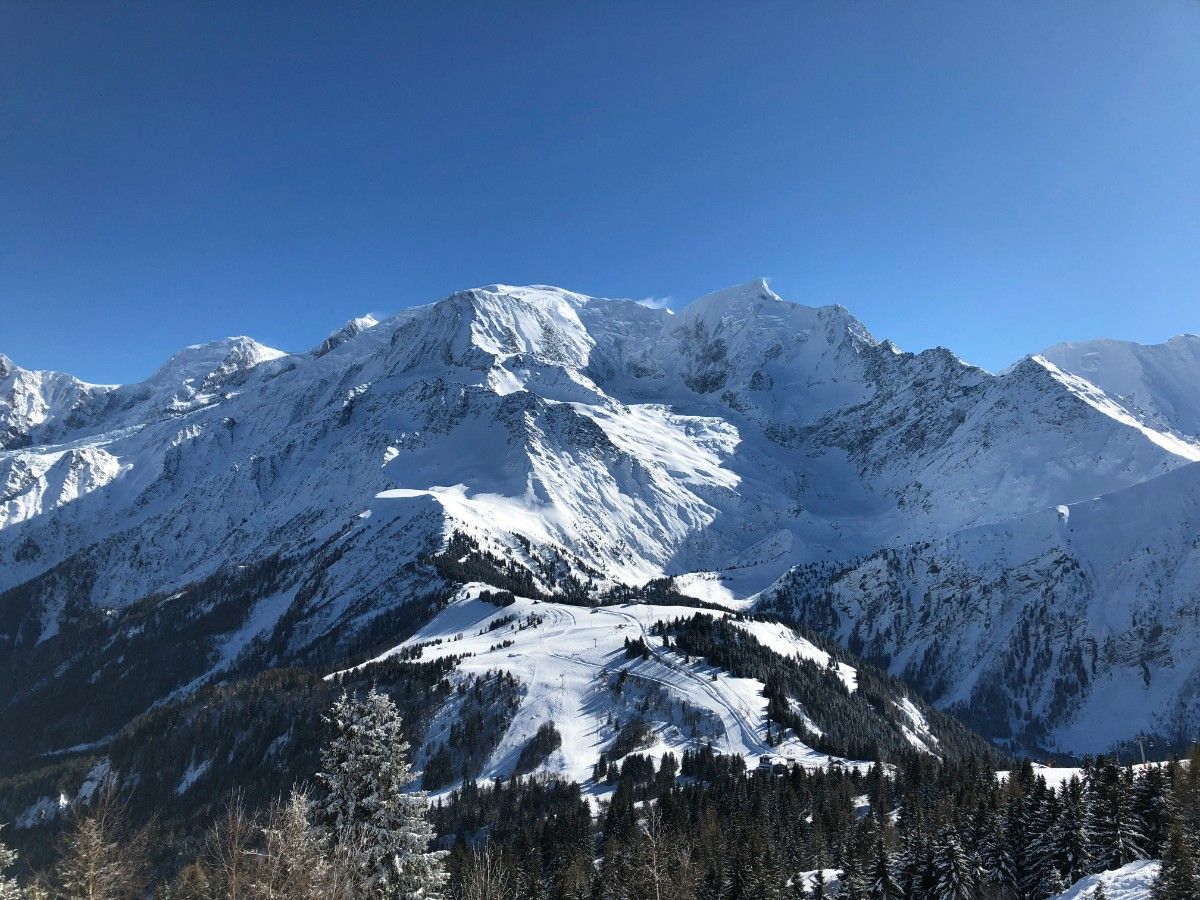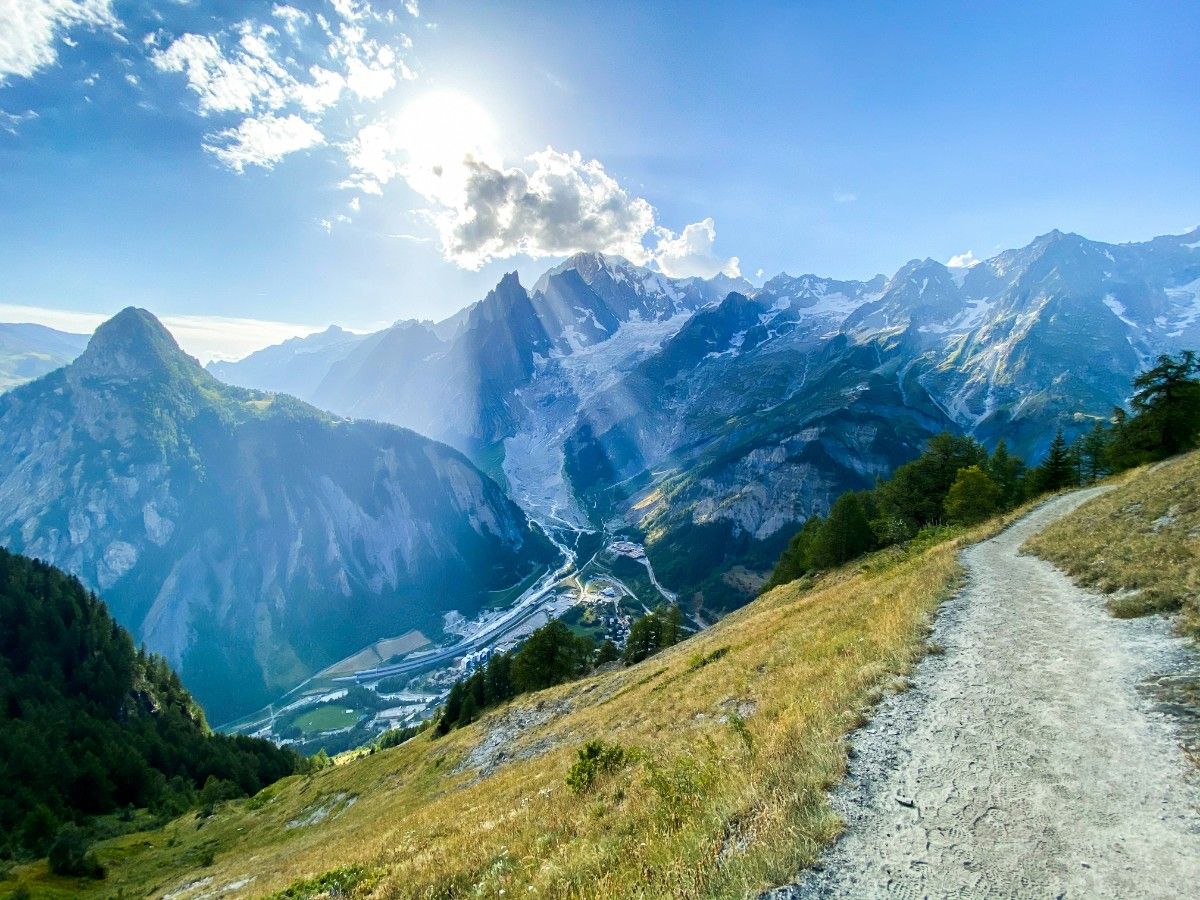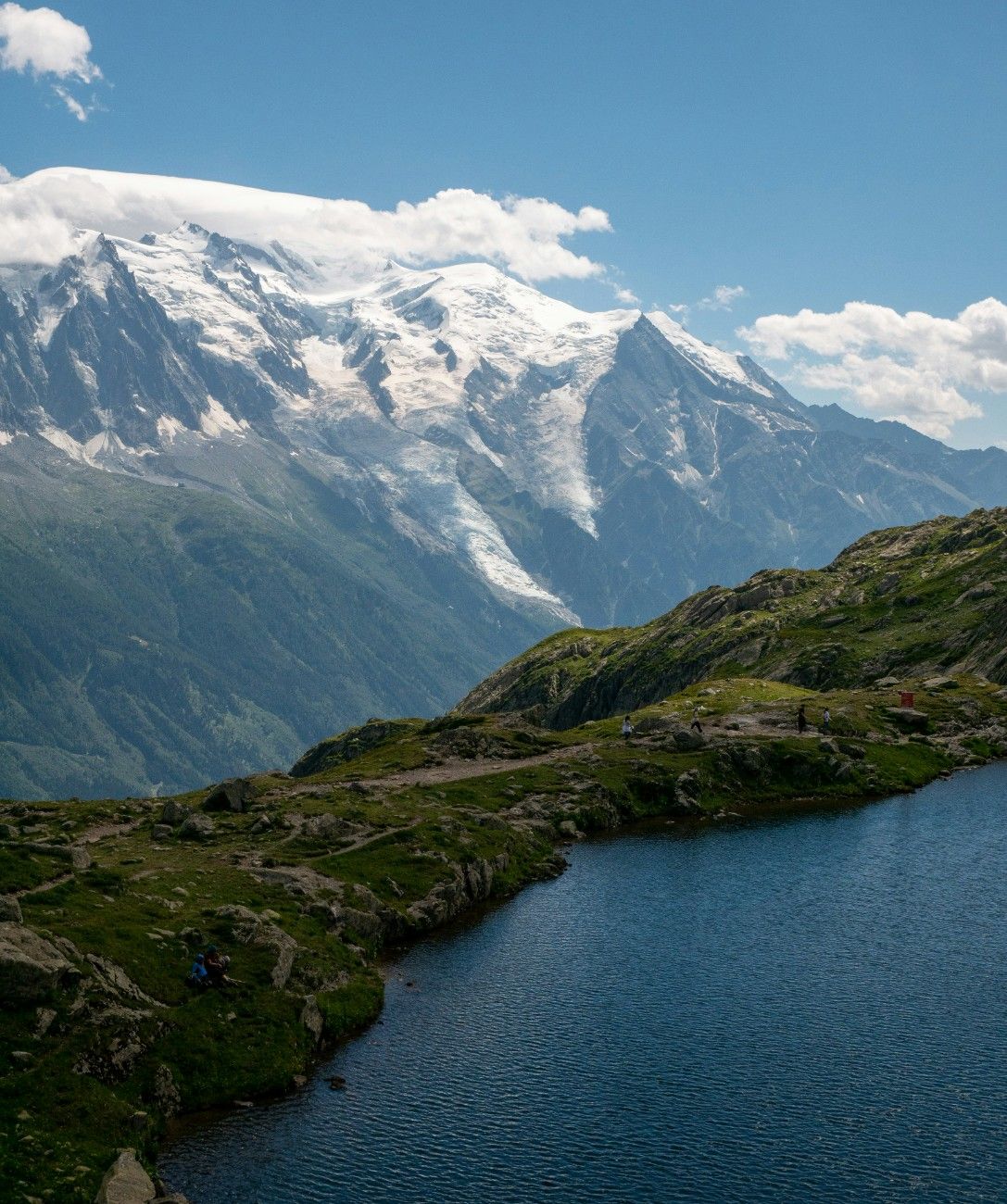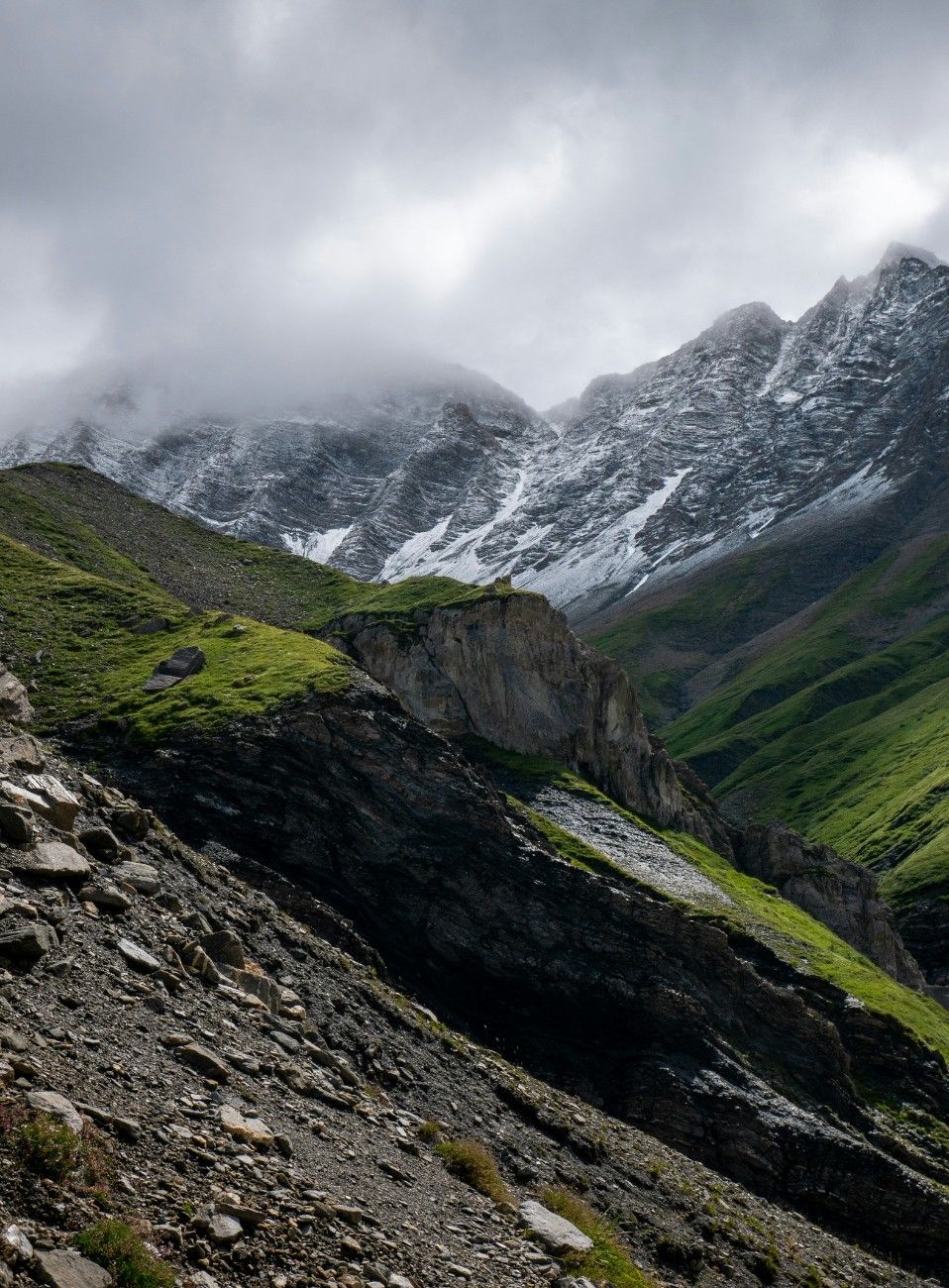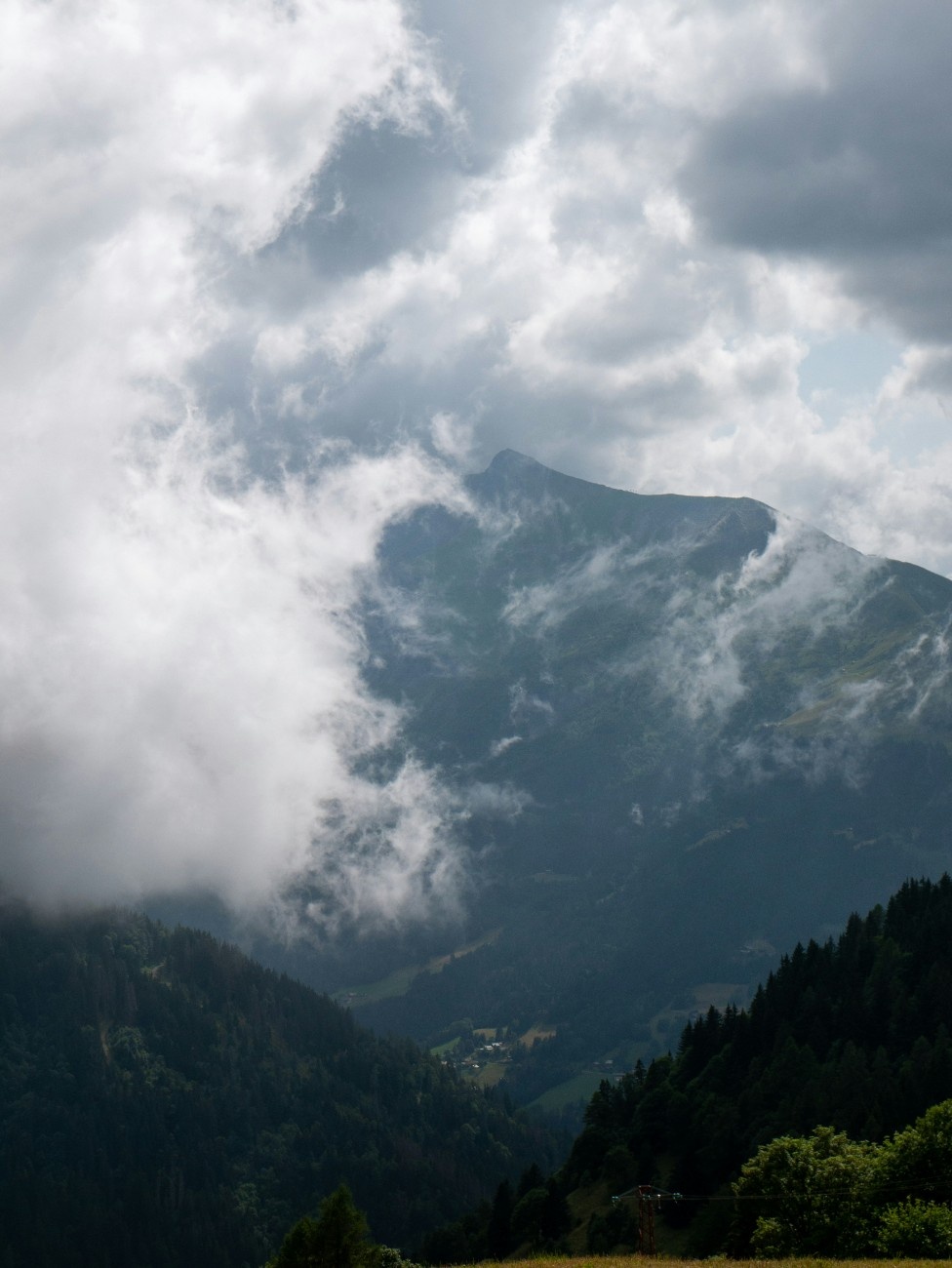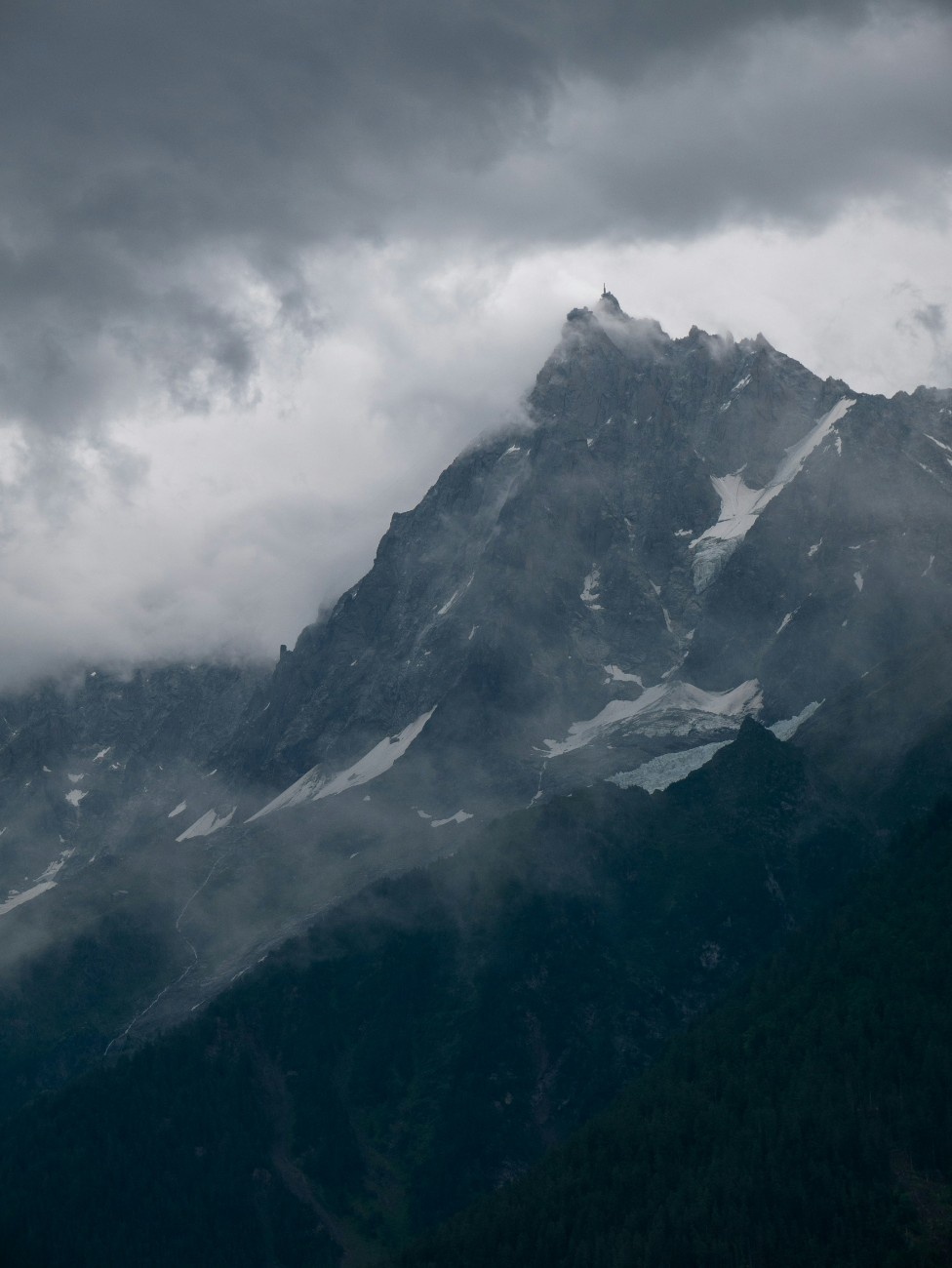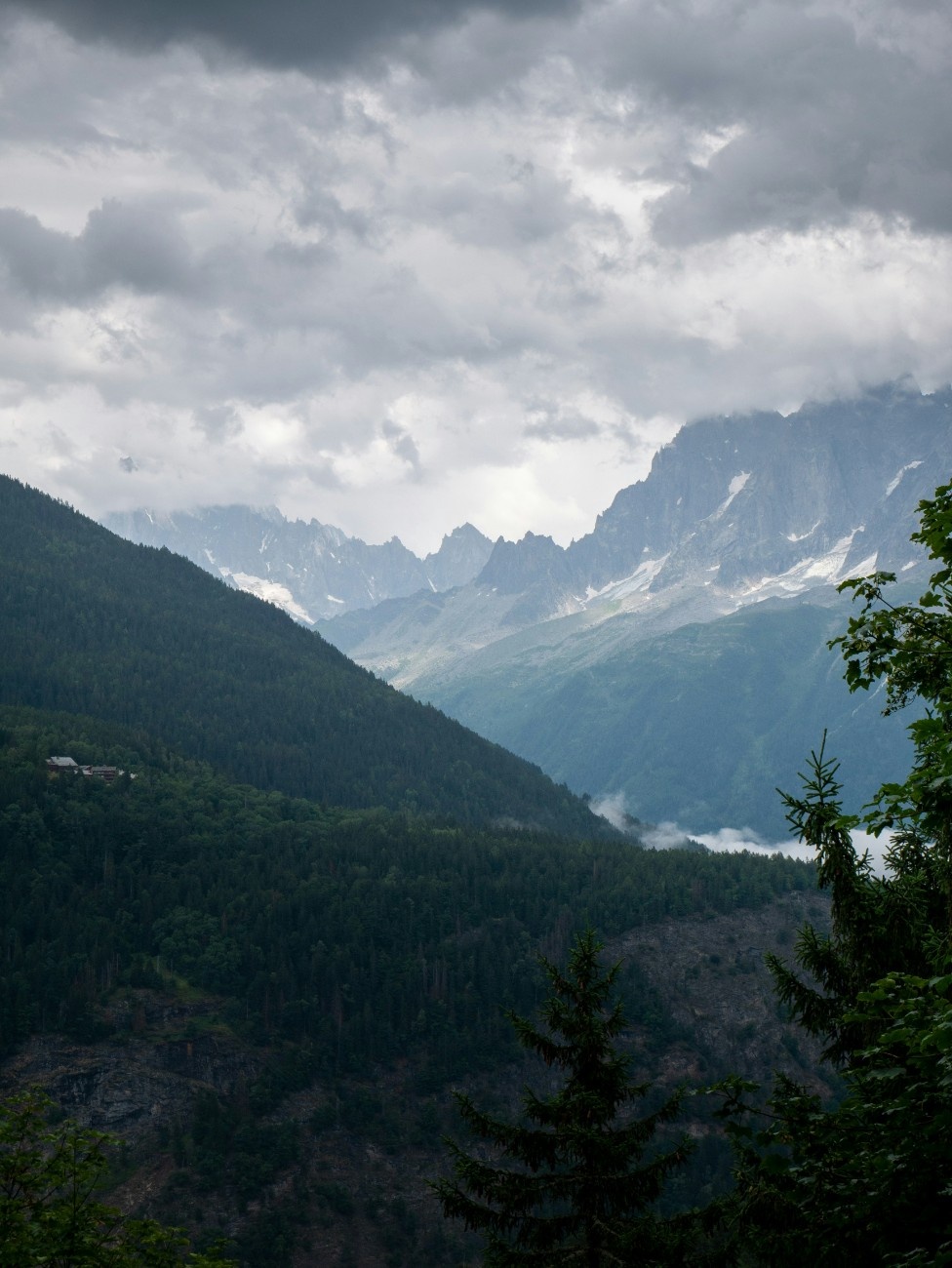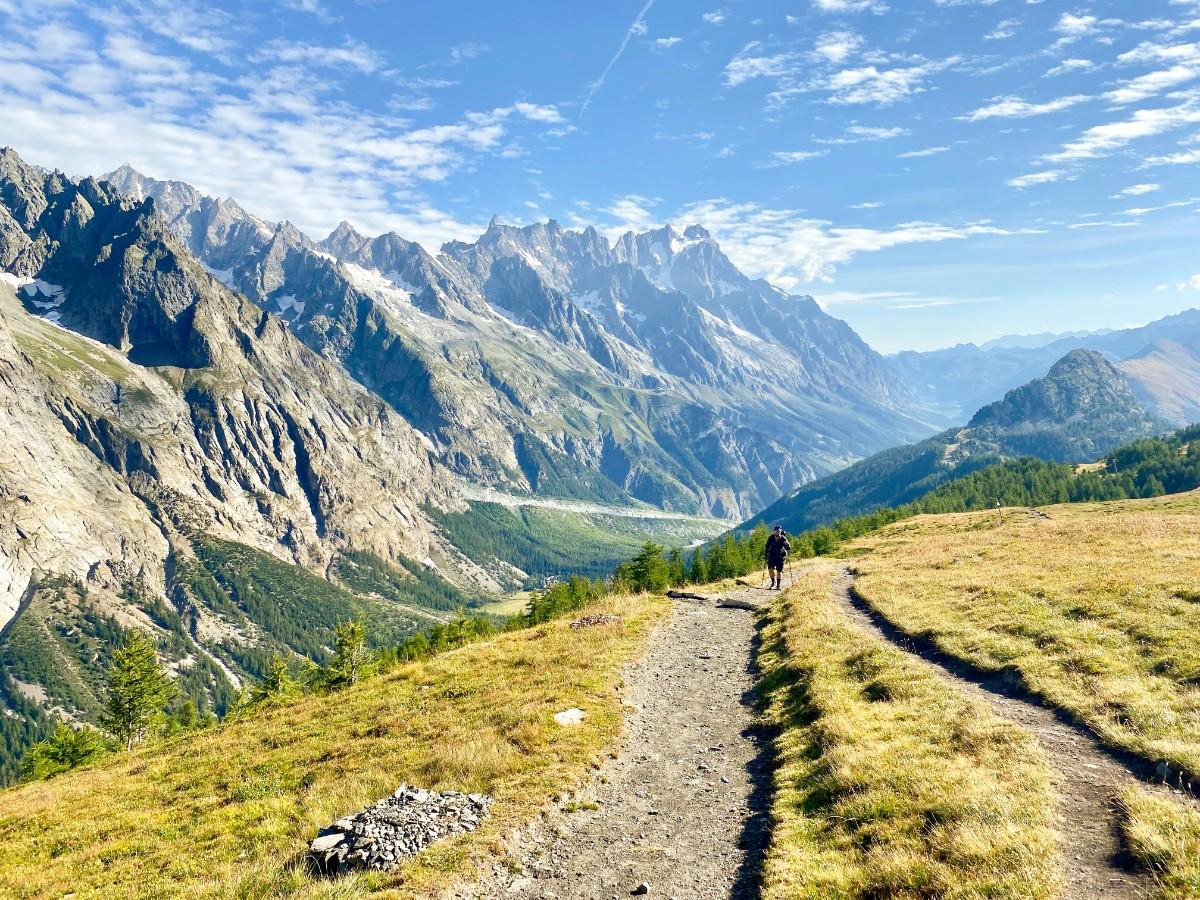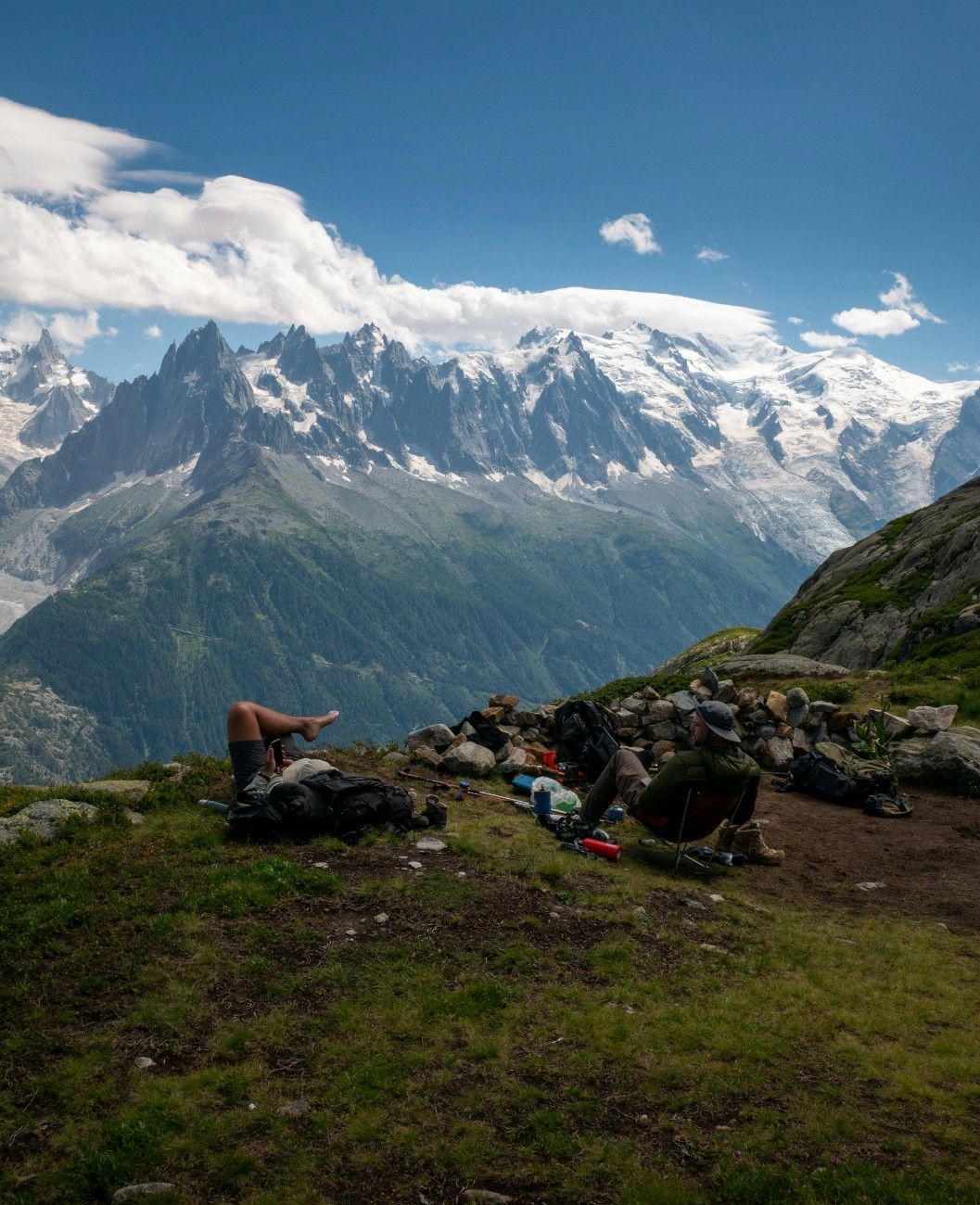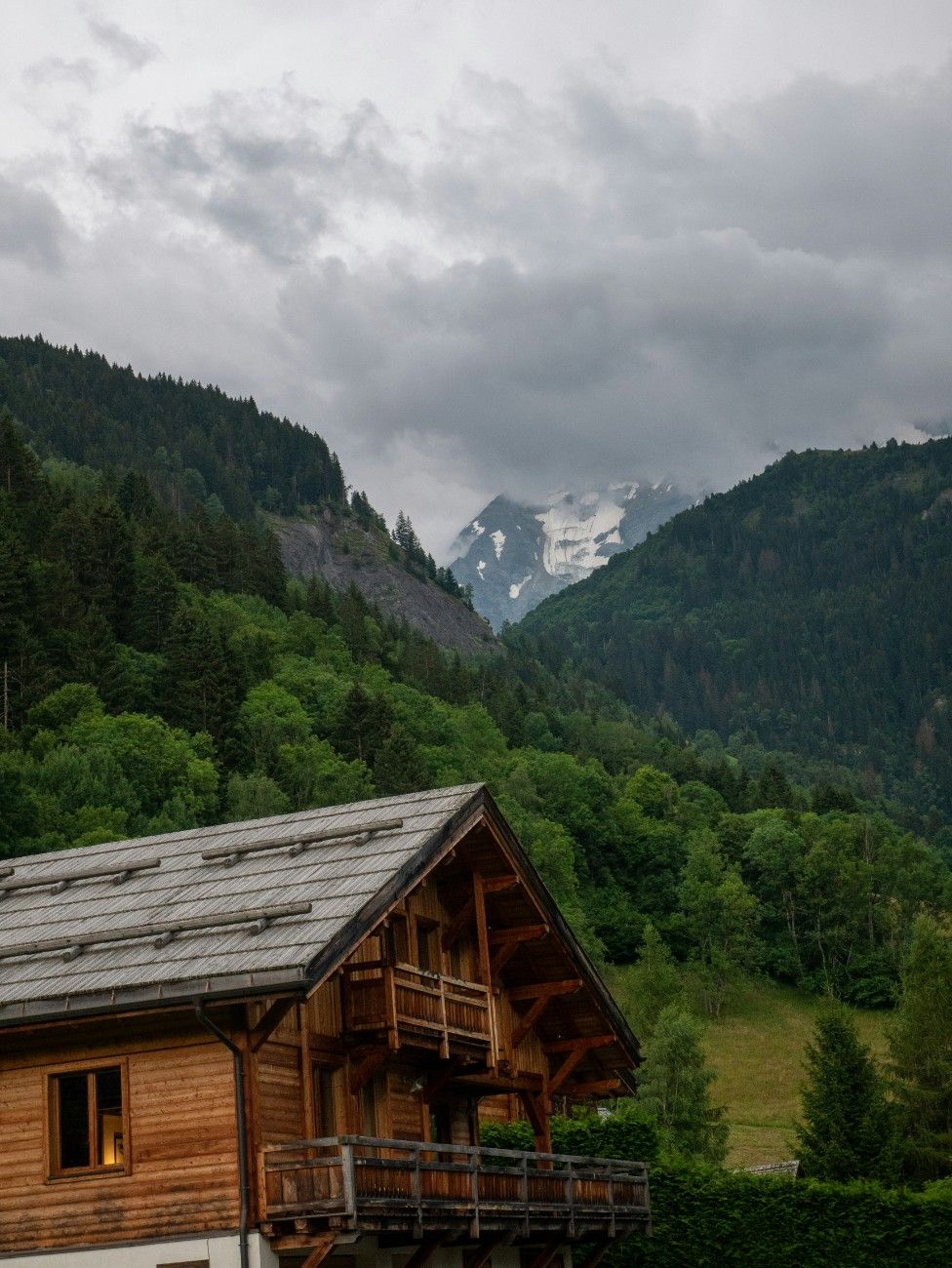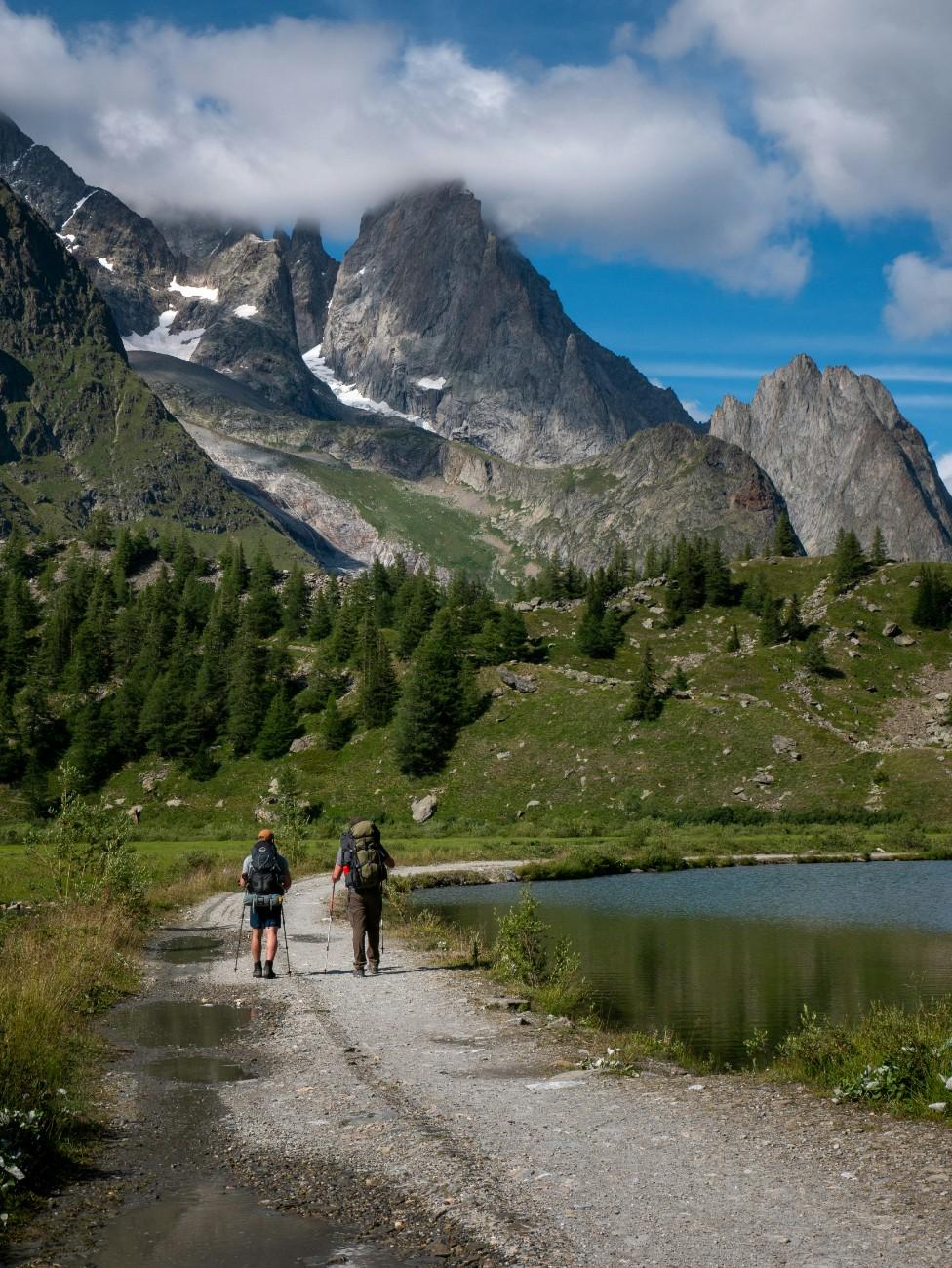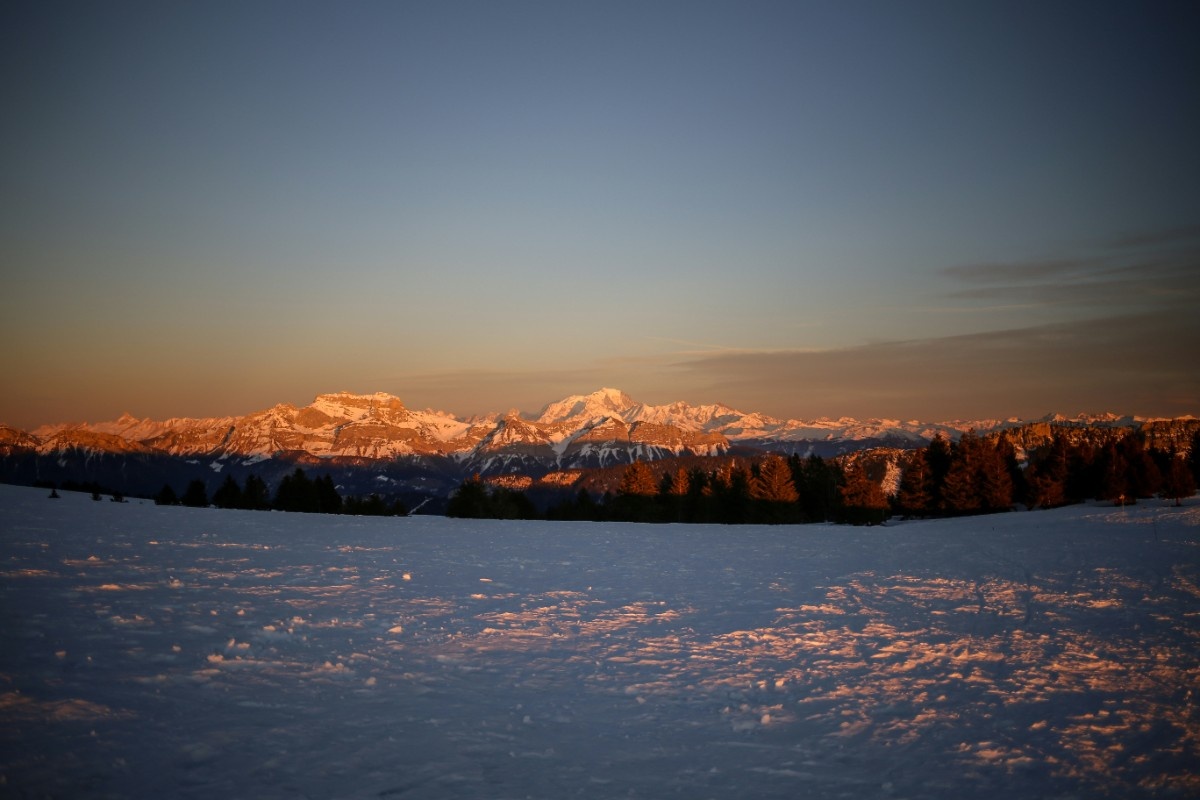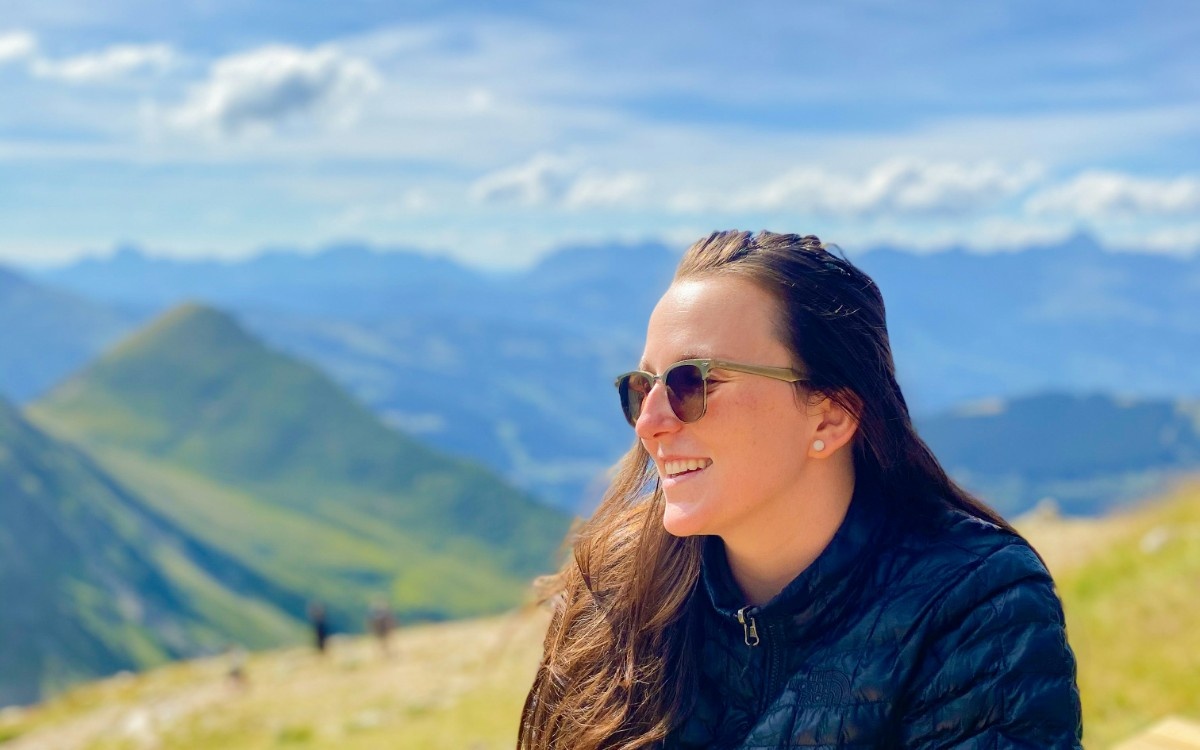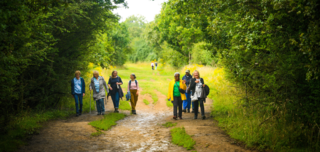Introducing the Tour du Mont Blanc
What is the Tour du Mont Blanc?
The Tour du Mont Blanc (TMB) is a world-renowned, long-distance hiking trail that traverses through the breathtaking landscapes of the European Alps. This iconic route encircles the majestic Mont Blanc massif, the highest mountain in Western Europe, covering a distance of approximately 170 kilometres (110 miles). The TMB takes hikers on an incredible journey through three countries: France, Italy, and Switzerland, offering a diverse range of landscapes, from lush valleys and charming mountain villages to rugged peaks and glaciers. The trail is typically completed in a counterclockwise direction, starting and ending in the picturesque French town of Les Houches, near Chamonix.
The Tour du Mont Blanc is not only a physical challenge but also a cultural experience, as it passes through distinct regions with their own unique traditions, languages, and cuisines. Along the way, hikers have the opportunity to stay in a variety of accommodations, including traditional mountain huts, guesthouses, and camping sites, each offering its own charm and hospitality. The TMB attracts hikers from all over the world, creating a vibrant and supportive community of outdoor enthusiasts who share a passion for nature, adventure, and personal growth.
History and Significance of the TMB
The Tour du Mont Blanc has a rich history dating back to the 18th century when the first recorded circumnavigation of the Mont Blanc massif was undertaken by Horace-Bénédict de Saussure, a Swiss naturalist and explorer. However, it wasn't until the 1950s that the TMB began to gain popularity as a long-distance hiking trail. The route was officially established and signposted in the 1960s, thanks to the efforts of the French, Italian, and Swiss alpine clubs.
Over the years, the Tour du Mont Blanc has become a symbol of international cooperation and a celebration of the shared natural and cultural heritage of the Alpine regions. The trail has played a significant role in promoting sustainable tourism, encouraging hikers to respect and appreciate the delicate mountain environment while supporting local communities and economies. The TMB has also inspired countless individuals to push their limits, overcome personal challenges, and forge deep connections with nature and fellow hikers from around the world.
Today, the Tour du Mont Blanc is recognised as one of the most spectacular and rewarding long-distance hiking trails in Europe, attracting thousands of hikers each year. The trail's popularity has led to the development of a well-established infrastructure, including a network of mountain huts, detailed guidebooks, and professional guiding services, making it accessible to hikers of various skill levels and backgrounds.
Planning Your Tour du Mont Blanc Hike
Best Time to Hike the TMB
When planning your Tour du Mont Blanc hike, one of the most important factors to consider is the timing of your trip. The hiking season for the TMB typically runs from mid-June to mid-September, when the weather is most stable, and the mountain huts are open. However, the best time to embark on your adventure depends on your preferences and priorities.
If you desire more solitude on the trail and don't mind cooler temperatures, consider hiking in the shoulder seasons of mid-June to early July or early to mid-September. During these periods, the trails are less crowded, and the mountain huts are less busy, allowing for a more tranquil and intimate experience. Keep in mind that there may still be some snow on the higher passes early in the season, and some huts may have limited services or be closed altogether.
Peak season for the TMB is typically from mid-July to late August, coinciding with the European summer holidays. This period offers the most stable weather conditions, with warmer temperatures and longer daylight hours. However, it also means that the trail and huts are at their busiest, with larger crowds and potential challenges in securing accommodation. If you plan to hike during this time, it's essential to book your hut reservations well in advance and be prepared for a more social and lively atmosphere on the trail.
Physical Preparation and Training
Hiking the Tour du Mont Blanc is a significant physical challenge that requires proper preparation and training. The trail involves long days of hiking, with steep ascents and descents, and covers a total elevation gain and loss of around 10,000 metres (32,800 feet). To ensure a safe and enjoyable experience, it's crucial to start your training well in advance of your trip.
Begin by building a strong foundation of cardiovascular endurance through activities like hiking, running, cycling, or swimming. Gradually increase the duration and intensity of your workouts to simulate the demands of the trail. Incorporate strength training exercises that target your legs, core, and upper body to improve your overall stability and power. Squats, lunges, step-ups, and calf raises are excellent exercises to strengthen your lower body, while planks, push-ups, and rows help develop your core and upper body.
As your fitness improves, include longer hikes with significant elevation gains and losses in your training plan. Aim to carry a backpack with a similar weight to what you'll be carrying on the TMB, gradually increasing the load as your strength and endurance grow. Practice hiking on varied terrains, including rocky and uneven paths, to prepare your body for the challenges of the trail.
In addition to physical training, it's essential to focus on your mental preparation. The TMB requires perseverance, adaptability, and a positive attitude in the face of challenges such as inclement weather, fatigue, or unexpected changes in plans. Cultivate mental resilience through practices like mindfulness, goal-setting, and self-care, and surround yourself with a supportive network of fellow hikers or loved ones who can offer encouragement and motivation along the way.
Remember to allow sufficient time for rest and recovery in your training plan, as overtraining can lead to injury or burnout. Listen to your body, and adjust your training accordingly, gradually building up your mileage and intensity over time. By dedicating yourself to a well-rounded training plan and maintaining a positive mindset, you'll be well-prepared to take on the incredible challenge and adventure of hiking the Tour du Mont Blanc.
The Tour du Mont Blanc Route and Highlights
The French Section: Chamonix Valley and Les Houches
The Tour du Mont Blanc typically begins in the charming French town of Les Houches, located in the picturesque Chamonix Valley. As you set off on your journey, you'll be greeted by stunning views of the Mont Blanc massif and the surrounding peaks. The trail winds through lush forests and alpine meadows, offering glimpses of glaciers and waterfalls along the way.
One of the early highlights of the French section is the ascent to the Col de Voza, a high mountain pass that marks the border between France and Italy. From here, you'll enjoy panoramic views of the Chamonix Valley and the impressive Bionnassay Glacier. As you continue along the route, you'll pass through the charming village of Les Contamines-Montjoie, known for its traditional Savoyard architecture and delightful local cuisine.
The trail then leads you to the Col du Bonhomme, one of the highest points on the TMB at 2,329 metres (7,641 feet). This challenging ascent rewards hikers with breathtaking views of the surrounding peaks and the Vallée des Glaciers. The French section concludes with a descent into the Vallée des Chapieux, where you'll find a selection of accommodations and the opportunity to sample more of the region's delicious specialties.
The Italian Section: Courmayeur and Val Ferret
As you cross the border into Italy, the Tour du Mont Blanc takes on a distinctly different character, with a more rugged and remote landscape. The trail leads you through the stunning Val Ferret, a valley known for its dramatic glaciers and towering peaks. One of the highlights of this section is the ascent to the Rifugio Bonatti, a spectacularly situated mountain hut that offers incredible views of the Italian side of Mont Blanc.
The Italian section of the route is often considered the most challenging, with steep ascents and rocky terrain. However, the breathtaking scenery and warm hospitality of the rifugios make it all worthwhile. As you make your way towards Courmayeur, you'll pass through the picturesque Val Veny, dotted with traditional alpine villages and offering views of the impressive Brenva Glacier.
Courmayeur itself is a charming Italian town, known for its vibrant atmosphere and excellent restaurants. It's the perfect place to take a rest day, explore the local sights, and indulge in some delicious Italian cuisine before continuing on your Tour du Mont Blanc hike.
The Swiss Section: Champex and the Fenêtre d'Arpette
The Swiss section of the Tour du Mont Blanc offers some of the most breathtaking scenery and challenging terrain of the entire route. As you leave Italy and cross into Switzerland, you'll be greeted by the picturesque town of La Fouly, nestled in the Val Ferret. From here, the trail climbs steadily through lush forests and alpine pastures, offering stunning views of the surrounding peaks and glaciers.
One of the highlights of the Swiss section is the charming lakeside village of Champex, known for its crystal-clear waters and stunning mountain backdrop. This is a popular spot for hikers to take a rest day, enjoy a swim in the lake, and sample some of the delicious local cuisine.
From Champex, the trail continues to the challenging Fenêtre d'Arpette, a high mountain pass at 2,665 metres (8,743 feet) that offers incredible views of the Trient Glacier and the surrounding peaks. The ascent to the pass is steep and rocky, but the stunning panoramas from the top make it well worth the effort.
After descending from the Fenêtre d'Arpette, hikers will pass through the picturesque Swiss villages of Trient and Vallorcine before crossing back into France for the final stage of the Tour du Mont Blanc. The Swiss section of the TMB is a true highlight of the route, offering a perfect blend of stunning scenery, challenging terrain, and charming alpine villages.
Self-Guided vs. Guided Tours on the TMB
Self-Guided Tours: Freedom and Flexibility
For hikers who value independence and enjoy the challenge of navigating the trail on their own, a self-guided tour of the Tour du Mont Blanc can be an excellent choice. Self-guided tours offer the freedom to set your own pace, customise your itinerary, and immerse yourself in the experience without the constraints of a group or predetermined schedule.
When embarking on a self-guided tour, you'll be responsible for planning your route, booking accommodations, and arranging transportation to and from the trailheads. This requires a certain level of logistical savvy and self-sufficiency, but it also allows you to tailor the experience to your specific interests and needs. You can choose to spend more time in certain areas, take rest days when needed, and make spontaneous detours or side trips along the way.
One of the key benefits of a self-guided tour is the sense of accomplishment and personal growth that comes with navigating the trail independently. You'll develop valuable skills in map reading, decision-making, and problem-solving, as well as a deeper connection to the landscape and your own capabilities. Self-guided tours also tend to be more budget-friendly than guided options, as you won't be paying for the services of a guide or the overhead costs associated with an organised group.
However, it's important to note that self-guided tours require a higher level of preparation and responsibility. You'll need to be comfortable with map reading, have a good understanding of the trail and its challenges, and be prepared to handle any unexpected situations that may arise. It's essential to carry a detailed map and guidebook, as well as a reliable GPS device or smartphone app, to ensure that you stay on track and can navigate any tricky sections of the trail.
Guided Tours: Support and Camaraderie
For hikers who prefer a more structured and supported experience, a guided tour of the Tour du Mont Blanc can be an excellent choice. Guided tours offer the benefit of an experienced professional who can provide expert knowledge, logistical support, and a sense of camaraderie along the way.
When joining a guided tour, you'll be part of a group of like-minded hikers, often from diverse backgrounds and nationalities. This can be a wonderful opportunity to make new friends, share experiences, and learn from one another as you tackle the trail together. Your guide will be responsible for leading the group, setting the pace, and providing information about the landscape, wildlife, and cultural heritage of the region.
One of the key advantages of a guided tour is the peace of mind that comes with having a knowledgeable and experienced leader. Your guide will have a deep understanding of the trail, including the best routes, potential hazards, and local weather patterns. They can provide guidance on pacing, nutrition, and gear, as well as offer support and encouragement when the going gets tough.
Guided tours also tend to include additional amenities and services, such as luggage transfers between accommodations, group meals, and transportation to and from the trailheads. This can be especially appealing for hikers who prefer a more comfortable and convenient experience, without the added stress of logistical planning.
However, it's important to note that guided tours do come at a higher cost than self-guided options, as you'll be paying for the expertise and support of a professional guide, as well as any additional services or amenities included in the package. Guided tours also tend to have a more fixed itinerary and schedule, which may not allow for as much flexibility or spontaneity as a self-guided tour.
Ultimately, the choice between a self-guided and guided tour of the Tour du Mont Blanc will depend on your personal preferences, hiking experience, and desired level of support. Both options offer unique benefits and challenges, and either can be an incredibly rewarding way to experience this iconic trail.
Camping on the Tour du Mont Blanc
Campsite Options and Regulations
For hikers looking to immerse themselves in nature and save on accommodation costs, camping along the Tour du Mont Blanc can be a rewarding experience. However, it's essential to be aware of the regulations and limitations surrounding camping on the TMB. Wild camping (setting up your tent anywhere along the trail) is not permitted in most areas, as the trail passes through protected natural parks and private land.
Instead, hikers who wish to camp must stay at designated campsites or use the camping facilities provided by some mountain huts. These designated campsites offer basic amenities such as toilets, water sources, and sometimes showers, making them a more comfortable and convenient option than wild camping.
When planning your camping itinerary, it's crucial to research the locations of the designated campsites and ensure they align with your desired route and daily distances. Some popular campsites along the TMB include Les Houches, Trient, Champex, Courmayeur, and Les Chapieux. Keep in mind that campsites can vary in terms of facilities and availability, so it's always a good idea to have a backup plan or alternative options in case your preferred campsite is full or closed.
Camping Gear and Preparation
Camping on the Tour du Mont Blanc requires additional gear and preparation compared to staying in mountain huts. In addition to your standard hiking gear, you'll need to carry a tent, sleeping bag, sleeping pad, and cooking equipment, which can add significant weight to your backpack.
When selecting your camping gear, it's essential to prioritise lightweight and compact equipment to minimise the impact on your body during long days on the trail. A lightweight, three-season tent with good waterproofing and ventilation is ideal for the TMB. Look for a sleeping bag with a temperature rating appropriate for the season and a lightweight, inflatable sleeping mat for insulation and comfort.
For cooking, a lightweight backpacking stove, fuel, and compact cookware set will allow you to prepare simple meals and hot drinks at your campsite. Don't forget to pack a reliable water filtration system or purification tablets to ensure access to safe drinking water throughout your journey.
In terms of food, it's essential to plan your meals and snacks carefully to ensure you have enough sustenance for the duration of your trip. Look for lightweight, non-perishable options such as dehydrated meals, energy bars, and trail mix. Be sure to pack enough food to cover any potential delays or unexpected changes in your itinerary.
When camping on the TMB, it's crucial to practice Leave No Trace principles to minimise your impact on the delicate alpine environment. This includes properly disposing of waste, minimising campfire impact, and respecting wildlife and other hikers. By following these guidelines and being well-prepared with the necessary gear, camping on the Tour du Mont Blanc can be a truly immersive and unforgettable experience.
Essential Gear and Packing List for the TMB
Clothing and Footwear
When packing for the Tour du Mont Blanc, it's essential to choose clothing and footwear that will keep you comfortable, dry, and protected from the elements. The key is to pack lightweight, quick-drying, and versatile layers that can be easily added or removed as the weather changes.
Start with a base layer of moisture-wicking, quick-drying underwear and t-shirts to keep you dry and comfortable. Add a mid-layer of lightweight fleece or wool for insulation, and a waterproof and breathable outer layer (jacket and trousers) to protect you from wind and rain. Don't forget to pack a warm hat, gloves, and a buff or neck gaiter for added warmth and sun protection.
For footwear, a sturdy pair of hiking boots with good ankle support and a Vibram sole is essential. Make sure to break in your boots before your trip to prevent blisters and discomfort. Pack several pairs of moisture-wicking, quick-drying hiking socks to keep your feet dry and blister-free.
Backpack and Sleeping System
Your backpack is your home away from home on the Tour du Mont Blanc, so it's essential to choose one that fits well, distributes weight evenly, and has enough capacity for all your gear. A backpack with a capacity of 40-60 litres is typically sufficient for the TMB, depending on whether you're staying in mountain huts or camping.
When selecting a sleeping system, comfort and warmth are key. If you're staying in mountain huts, a lightweight sleeping bag liner and a compressible travel pillow may be sufficient. However, if you're camping, you'll need a warm sleeping bag (rated for the expected temperatures), a lightweight sleeping mat for insulation and comfort, and a tent that can withstand the alpine conditions.
Other Essential Items
In addition to clothing, footwear, and your sleeping system, there are several other essential items to include on your TMB packing list. These include:
- Map and compass (or GPS device) for navigation
- Headtorch or handheld torch for navigating in the dark
- First-aid kit with blister treatment, pain relievers, and any personal medications
- Sunscreen, sunglasses, and a sun hat for sun protection
- Insect repellent for protection against bugs and ticks
- Water bottles or hydration system (with water filtration or purification method)
- Lightweight, quick-drying towel for hygiene
- Pocket knife or multi-tool for emergencies and repairs
- Camera or phone for capturing memories (don't forget a power bank and charging cables)
- Cash and credit card for hut fees, meals, and emergencies
Remember, the key to packing for the TMB is to strike a balance between having all the necessary gear and keeping your backpack as light as possible. By carefully selecting versatile, lightweight, and high-quality items, you can ensure that you have everything you need for a safe and enjoyable hike without being weighed down by unnecessary items.
Weather and Climate on the Tour du Mont Blanc
Seasonal Weather Patterns
The weather on the Tour du Mont Blanc can be highly variable, with conditions changing rapidly depending on the season, elevation, and local microclimates. The hiking season typically runs from mid-June to mid-September, with July and August being the warmest and busiest months.
In early summer (mid-June to early July), hikers can expect cooler temperatures, with daytime highs around 15-20°C and nighttime lows around 5-10°C. There may still be some snow on the higher passes, and the trail can be muddy and slippery in places. However, this time of year also offers the chance to see alpine wildflowers in full bloom.
Mid-summer (July to August) brings warmer temperatures, with daytime highs around 20-25°C and nighttime lows around 10-15°C. This is the peak season for hiking the TMB, with generally stable weather and long daylight hours. However, afternoons can bring thunderstorms and heavy rain, so it's essential to be prepared with waterproof gear.
In late summer and early fall (September to early October), temperatures start to cool down again, with daytime highs around 15-20°C and nighttime lows around 5-10°C. While the weather can be more unpredictable, with a higher chance of snow on the passes, this time of year offers the opportunity for a quieter and more peaceful hiking experience.
Altitude and Weather Considerations
The Tour du Mont Blanc reaches elevations of over 2,500 metres (8,200 feet) at several points along the route, which can have a significant impact on the weather and hiking conditions. At higher altitudes, the air is thinner and colder, and the risk of altitude sickness increases. It's essential to be aware of the symptoms of altitude sickness (headache, nausea, fatigue) and to descend to a lower elevation if necessary.
The higher elevations also mean that weather conditions can change rapidly, with sudden storms, high winds, and freezing temperatures possible even in the middle of summer. It's crucial to be prepared with warm, waterproof layers and to check the weather forecast regularly.
In addition to the challenges of altitude, the TMB also passes through several microclimates, with significant variations in temperature and precipitation depending on the location and orientation of the trail. For example, the Italian side of the route tends to be drier and sunnier than the French and Swiss sides, while the valleys can be significantly warmer than the passes.
By being aware of these weather and climate considerations and packing accordingly, hikers can ensure a safe and enjoyable experience on the Tour du Mont Blanc.
Cultural Experiences and Local Cuisine on the TMB
Unique Alpine Cultures
One of the most rewarding aspects of hiking the Tour du Mont Blanc is the opportunity to immerse oneself in the unique cultures of the Alpine regions of France, Italy, and Switzerland. Each section of the trail offers its own distinct traditions, languages, and ways of life, providing a rich and diverse cultural experience for hikers.
In the French section of the route, hikers can expect to encounter the charming villages and warm hospitality of the Savoie region. The local dialect, Savoyard, is still spoken in many of the mountain communities, and the architecture is characterised by traditional stone and wood chalets. The French section of the trail also passes through the bustling town of Chamonix, a mecca for mountaineers and outdoor enthusiasts from around the world.
Crossing into Italy, hikers will experience the laid-back atmosphere and delicious cuisine of the Aosta Valley. The Italian section of the route is known for its sunny weather, stunning views of the Italian side of Mont Blanc, and charming mountain rifugios. The town of Courmayeur, with its cobblestone streets and lively piazzas, is a highlight of this section.
Finally, the Swiss section of the Tour du Mont Blanc offers a glimpse into the traditional mountain culture of the Valais region. The villages along this part of the route are known for their picturesque wooden chalets, colourful flower boxes, and friendly locals. The town of Champex, with its stunning alpine lake and backdrop of snow-capped peaks, is a particular highlight.
Delicious Local Specialties
In addition to the stunning scenery and cultural experiences, one of the great joys of hiking the Tour du Mont Blanc is the opportunity to sample the delicious local cuisine of the Alpine regions. Each section of the trail offers its own unique specialties and culinary traditions, making mealtimes a highlight of the hiking day.
In the French section of the route, hikers can expect to enjoy hearty Savoyard dishes such as tartiflette (a rich gratin of potatoes, bacon, and reblochon cheese), raclette (melted cheese served with potatoes, cured meats, and pickles), and fondue. The local wines, such as Mondeuse and Roussette, are also not to be missed.
Crossing into Italy, hikers will have the chance to sample the delicious pasta, pizza, and polenta dishes of the Aosta Valley. The Italian rifugios are known for their excellent home-cooked meals, often featuring local ingredients such as fontina cheese and porcini mushrooms. The town of Courmayeur is also home to several excellent restaurants, offering everything from traditional Italian fare to international cuisine.
Finally, the Swiss section of the Tour du Mont Blanc is a paradise for cheese lovers, with local specialties such as raclette and fondue available at many of the mountain huts and restaurants. The Swiss are also known for their delicious pastries and baked goods, such as the dense and flavourful rye bread known as valais. The town of Champex is a great place to sample some of these local delicacies, with several excellent bakeries and cafes.
By taking the time to sample the local cuisine and engage with the unique cultures of the Alpine regions, hikers on the Tour du Mont Blanc can deepen their appreciation for the rich traditions and ways of life of these mountain communities.
Related Articles

Let us know you agree to cookies
We use marketing, analytical and functional cookies as well as similar technologies to give you the best experience. Third parties, including social media platforms, often place tracking cookies on our site to show you personalised adverts outside of our website.
We store your cookie preferences for two years and you can edit your preferences via ‘manage cookies’ or through the cookie policy at the bottom of every page. For more information, please see our cookie policy.
